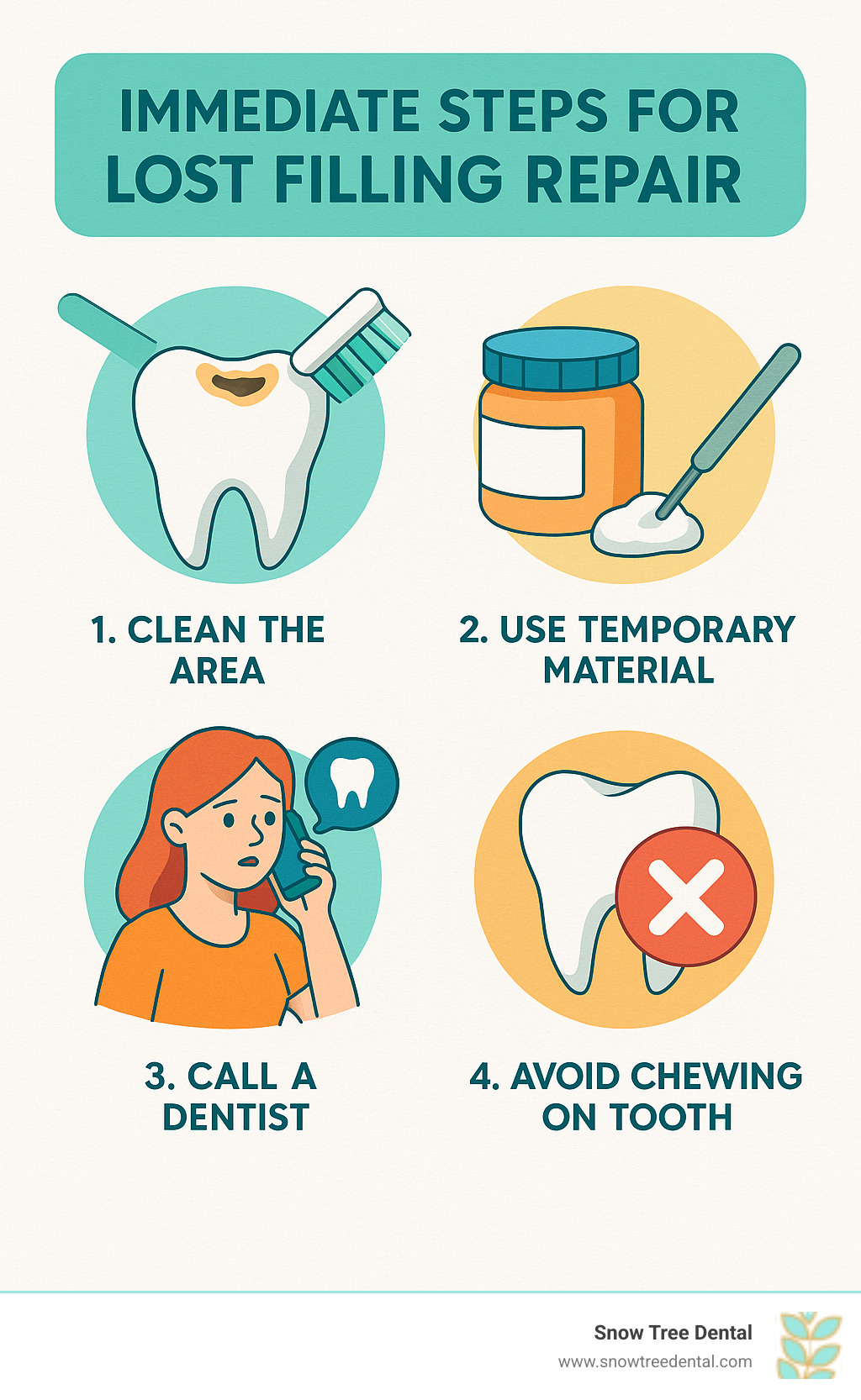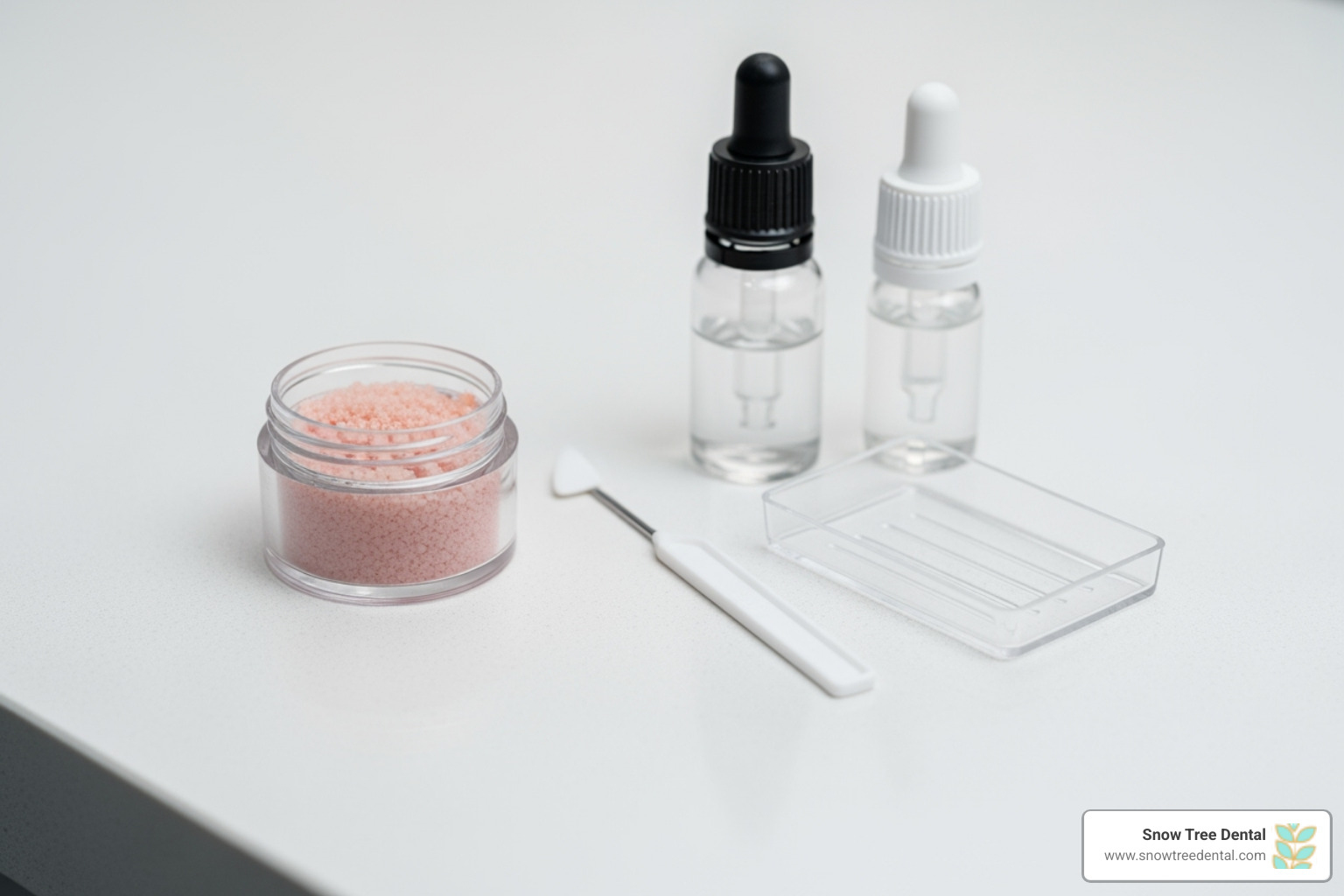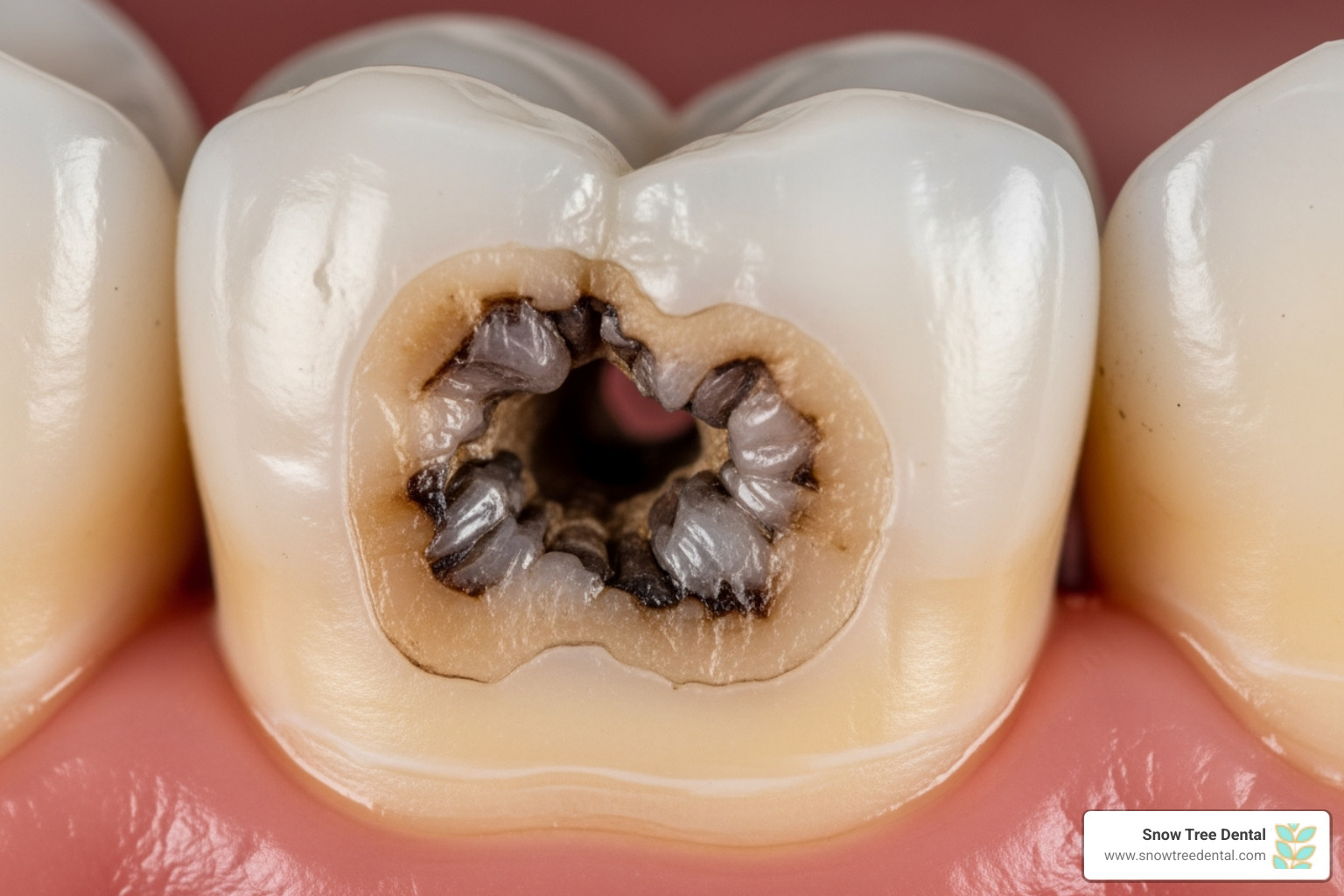Lost Filling Repair: 1st Aid for Emergencies
When Dental Disasters Strike: Understanding Lost Filling Emergencies
Lost filling repair becomes an urgent concern when you’re suddenly dealing with a sensitive, exposed tooth that wasn’t bothering you just moments before. Whether you bit into something crunchy or your old restoration simply gave way, knowing how to handle this common dental emergency can save you pain and prevent serious complications.
Immediate Steps for Lost Filling Repair:
- Save the filling – Rinse and store it safely
- Call your dentist – Schedule an emergency appointment
- Rinse with warm salt water – Keep the area clean
- Use temporary filling material – Available at most pharmacies
- Take pain relievers – Manage discomfort until treatment
- Avoid the affected side – Don’t chew on the exposed tooth
Losing a filling can feel scary, but it’s actually one of the most common dental issues that dentists handle every day. The exposed tooth becomes vulnerable to bacteria, food particles, and temperature changes, which explains the sudden sensitivity you might experience.
Most lost fillings aren’t true dental emergencies unless you’re experiencing severe pain, swelling, or sharp edges cutting your tongue. However, prompt attention within a few days prevents the simple problem from becoming a complex and expensive one.
As Dr. Muna Mohammad at Snow Tree Dental, I’ve helped countless Houston families handle lost filling repair situations with same-day appointments and gentle care. My experience treating dental emergencies has shown me that patients who act quickly often need only simple repairs, while those who wait may require more extensive treatments like crowns or root canals.

Why Your Dental Filling or Crown Fell Out
Picture this: you’re enjoying your favorite meal when suddenly you feel something hard rolling around in your mouth that definitely wasn’t on your plate. That uncomfortable moment when you realize your filling or crown has decided to take an unexpected vacation from your tooth is more common than you might think.
New decay is often the sneaky culprit behind lost filling repair emergencies. Even if your filling has been faithfully doing its job for years, decay can slowly develop around its edges. This fresh decay acts like a tiny demolition crew, weakening the tooth structure that keeps your restoration securely in place. Eventually, the foundation becomes so compromised that your filling simply can’t hold on anymore.
Sometimes it’s as simple as biting into something hard or sticky. That delicious caramel apple or perfectly crusty sourdough bread can generate enough force to pop out a filling or crown, especially if the bond has already started to weaken. It’s like the final straw that breaks the camel’s back – except the camel is your dental work.
Trauma or injury can also send your restoration flying. A fall, sports accident, or unexpected encounter with a door frame can create enough impact to dislodge even well-secured dental work. These situations often require immediate attention since the damage usually extends beyond just the lost restoration.
Every day, your teeth endure incredible wear and tear from chewing, grinding, and clenching. Your dental restorations are tough, but they’re not indestructible. Just like your favorite pair of jeans, they eventually show signs of aging and may need replacement after years of faithful service.
Teeth grinding, also known as bruxism, puts tremendous extra pressure on both your natural teeth and any restorations. If you’re a nighttime grinder, you’re essentially giving your dental work an intense workout while you sleep. This constant stress can gradually loosen fillings and crowns or even crack them outright. Information on teeth grinding can help you understand if this might be affecting your dental work.
Your daily diet plays a bigger role than you might expect. Regular consumption of acidic foods and drinks – think citrus fruits, sodas, and wine – can slowly erode both your tooth enamel and the bonding materials holding your restorations in place. This creates a weakened environment where fillings and crowns struggle to maintain their grip. The American Dental Association offers detailed information about how diet affects teeth and contributes to dental erosion.
Sometimes the problem lies with the dental cement itself or how the restoration was originally placed. Poor-quality cement or an imperfect fit from the beginning can lead to premature failure. Additionally, as we age, our mouths naturally change – teeth can shift, gums may recede, and these changes can affect how well existing restorations fit and function.
Telltale Signs Your Restoration is Loose
Your filling or crown usually gives you fair warning before it makes its grand exit. Learning to recognize these early signs can help you schedule a repair appointment before you’re dealing with a full dental emergency.
Increased sensitivity is often the first clue something’s not right. If a previously comfortable tooth suddenly starts reacting to hot coffee, cold ice cream, or even a cool breeze, your restoration might be loosening and allowing these sensations to reach the more sensitive inner layers of your tooth.
You might notice feeling pressure when biting down, especially in one particular spot. This uncomfortable sensation happens when a loose restoration shifts slightly under the force of chewing, creating an uneven surface that doesn’t feel quite right when your teeth come together.
Look for any visible crack or gap around the edges where your filling or crown meets your natural tooth. Even a tiny space means the protective seal is broken, creating an open invitation for bacteria to sneak in and cause new problems.
When you floss, pay attention if the floss catches on the edge of your restoration or starts shredding in that area. This suggests the smooth surface has become rough or uneven, indicating the restoration is no longer sitting flush with your tooth.
Finally, trust your bite. If something feels off when you chew – maybe your teeth don’t come together the same way they used to – this change in your bite could signal that a restoration has shifted position.
At Snow Tree Dental, we’ve found that patients who come in when they first notice these warning signs often need only simple repairs. Catching a loose filling or crown early can save you from more extensive and expensive treatments down the road.
What to Do Immediately After Losing a Filling or Crown
The moment you realize your filling or crown has fallen out, take a deep breath. Yes, it’s unsettling, but this happens to thousands of people every day, and with the right immediate steps, you can protect your tooth and stay comfortable until we can see you.

Your first move should be to call your dentist right away. Don’t wait until Monday if this happens on a weekend – dental problems rarely get better on their own, and waiting often means more complex treatment later. At Snow Tree Dental, we understand that dental emergencies don’t follow business hours, which is why we offer flexible scheduling and same-day appointments for Houston families dealing with urgent situations like lost filling repair.
If you can find your filling or crown, save it carefully. Rinse it gently with cool water to remove any debris, then store it in a small container or clean plastic bag. Sometimes we can actually re-cement a crown right back into place if it’s undamaged and your tooth is still healthy underneath.
Keep the exposed area clean with gentle rinsing. A saltwater rinse works wonderfully here – just mix half a teaspoon of salt into a cup of warm water and swish it around your mouth, focusing on the affected area. This simple solution reduces bacteria, helps prevent infection, and often provides soothing relief from sensitivity.
For pain management, you have several effective options. Over-the-counter pain relievers like ibuprofen or acetaminophen can significantly reduce discomfort – just follow the package directions carefully. If you prefer a natural approach, clove oil has been used for centuries to numb tooth pain. Apply just a tiny drop to a cotton swab and dab it gently on the sensitive area. You’ll find clove oil at most pharmacies, and a little goes a long way.
The golden rule while waiting for your appointment is simple: avoid chewing on that side of your mouth. Your exposed tooth is vulnerable now, and putting pressure on it can cause pain or even crack the remaining tooth structure.
How to Handle a Lost Filling vs. a Lost Crown
While both situations need prompt attention, the immediate care differs slightly depending on what you’ve lost.
When you’ve lost a filling, your main concern is protecting the newly exposed cavity from food particles and bacteria. Start by rinsing thoroughly with warm salt water, then gently examine the area with your tongue (not your fingers). If you feel any sharp edges that might cut your tongue or cheek, you can temporarily cover them with a small piece of sugar-free gum or dental wax from the pharmacy.
Over-the-counter temporary filling materials can be lifesavers in this situation. These kits, available at most drugstores, provide a temporary seal that protects your tooth and reduces sensitivity until you can get professional lost filling repair.
When you’ve lost a crown, you’re dealing with a different challenge. The exposed tooth underneath is often more sensitive because it was prepared specifically to fit under the crown. If you have the crown and it’s intact, you can try a temporary fix.
Clean both the crown and your tooth gently, then apply a tiny amount of temporary dental cement (available at pharmacies) or even plain toothpaste inside the crown. Carefully place it back on your tooth – make sure it’s facing the right direction – and bite down gently to seat it. This is just a temporary measure to protect your tooth, not a permanent solution.
Protecting the exposed tooth is critical in both situations. The inner layers of your tooth are much more sensitive than the outer enamel, which explains why you might suddenly feel pain from cold air or even your own saliva. Keep the area clean, avoid temperature extremes in food and drinks, and stick to soft foods until your appointment.
These temporary measures are just that – temporary. While they can keep you comfortable and protect your tooth, only professional treatment can properly restore your tooth’s function and prevent complications down the road.
Your Guide to At-Home Lost Filling Repair
When you’re dealing with a lost filling at 9 PM on a Saturday night, professional help might not be immediately available. That’s when temporary dental repair kits become your best friend for managing the situation until you can get proper care.

Most pharmacies carry temporary dental cement kits that can provide relief for hours or even days. These kits contain a putty-like material that hardens when it comes into contact with saliva, creating a temporary seal over your exposed tooth. Brands like DenTek and Dentemp are commonly available and surprisingly effective for short-term lost filling repair.
If you can’t find a dental repair kit, dental wax works well for covering sharp edges and reducing sensitivity. You can usually find this in the oral care aisle near the orthodontic supplies. The wax creates a protective barrier that prevents your tongue from getting cut and reduces exposure to hot and cold temperatures.
In a true pinch, sugar-free gum can serve as an emergency solution, though it’s far from ideal. The key word here is sugar-free – regular gum would feed bacteria and make the situation worse. This should only be used when absolutely nothing else is available, and you should replace it with proper temporary filling material as soon as possible.
The main goals of any temporary repair are protecting the exposed tooth from bacteria and alleviating sensitivity until you can see us. Think of it as putting a bandage on a cut – it’s not the final treatment, but it prevents further damage.
How to Use a Temporary Lost Filling Repair Kit
Using these kits isn’t rocket science, but following the right steps makes all the difference between success and frustration. Each kit is slightly different, so reading the instructions carefully is your first and most important step.
Start by washing your hands thoroughly – you’ll be working inside your mouth, and cleanliness matters. Clean and dry the tooth by rinsing gently with warm water and patting the area with a cotton swab. Some materials work better on completely dry surfaces, while others need slight moisture, so check your specific kit’s requirements.
Most temporary materials come as a paste or small pellets that you mix with your finger. Take a small amount – less is often more with these products. Apply the material by pressing it firmly into the cavity, making sure to fill the space completely without overfilling.
Here’s where patience pays off: bite down gently to shape the material to your natural bite pattern. Don’t chomp hard – just apply steady, gentle pressure to ensure the temporary filling doesn’t interfere with your other teeth when you close your mouth.
Let it set according to the package directions, usually about an hour or two. During this time, resist the urge to test it with your tongue or eat anything. Think of it like waiting for nail polish to dry – premature testing ruins the result.
Once it’s hardened, avoid sticky or hard foods that could pull out your temporary repair. Soft foods and room-temperature drinks are your friends until you can get professional treatment.
Is a Lost Filling a Dental Emergency?
This question keeps many people awake at night, literally. The honest answer is that most lost fillings fall into the “urgent but not critical” category. However, certain warning signs mean you should seek immediate help rather than waiting for regular office hours.
Severe pain that doesn’t respond to over-the-counter pain relievers signals a bigger problem. When the nerve inside your tooth becomes exposed or infected, the pain can be excruciating and won’t wait for Monday morning.
Watch out for sharp edges causing injury to your tongue or cheek. These cuts can become infected and make eating or speaking miserable. If you’re constantly getting cut, it’s time for emergency care.
Signs of infection are always serious. Swelling around the tooth, pus, or a persistent bad taste in your mouth means bacteria have set up shop in your exposed tooth. Swelling in your face or jaw is particularly concerning and shouldn’t be ignored.
A fever accompanying your lost filling suggests the infection may be spreading beyond your tooth. This combination always warrants immediate professional attention.
Even without these dramatic symptoms, don’t let a lost filling linger for weeks. The exposed tooth is vulnerable to further decay and damage. What starts as a simple lost filling repair can quickly become a need for a crown, root canal, or even extraction if left untreated.
At Snow Tree Dental, we understand that dental emergencies don’t follow business hours. That’s why we offer flexible scheduling and same-day appointments for situations just like this. A quick call can often save you from a much bigger problem down the road.
The Risks of Delay and the Benefits of Professional Repair
When a filling or crown comes loose, it creates an exposed area on your tooth that was once protected. Ignoring this opening, even if it doesn’t cause immediate pain, carries significant risks that can turn a simple problem into a major dental emergency.
Think of your exposed tooth like an open door that bacteria and food particles can freely enter. The risk of infection becomes very real once harmful bacteria reach the tooth’s inner structures. This bacterial invasion can lead to further tooth decay, eating away at the healthy tooth structure that’s left. What started as a simple lost filling repair can quickly spiral into something much more serious.
The weakened tooth structure becomes vulnerable to tooth fracture. Without the support of the filling or crown, the remaining tooth walls can chip, crack, or even break completely when you bite down. This is especially true for back teeth that handle most of your chewing forces.
When decay or damage reaches the pulp – the nerve center of your tooth – nerve damage becomes inevitable. You’ll likely experience persistent pain, extreme sensitivity, and eventually, the nerve may die completely. At this point, you’re looking at the need for root canal or extraction, turning what could have been a simple repair into a complex and expensive procedure.
The benefits of prompt care are substantial and can save you both pain and money. When you address a lost filling or crown quickly, we can often restore your tooth with a straightforward replacement. Preserving your natural tooth means you’ll continue to chew comfortably and confidently. Alleviating pain and sensitivity happens immediately once we seal off the exposed areas properly.
Most importantly, preventing infection protects not just that tooth, but your overall oral health. A proper repair restores full function to your tooth, and you’ll find that saving money in the long run makes prompt treatment a smart investment. A timely, simple repair almost always costs less than a root canal, extraction, or dental implant.
At Snow Tree Dental, we’ve seen too many patients wait until their discomfort becomes unbearable, only to find they need extensive treatment that could have been avoided. For more information on how we handle urgent situations like these, explore our emergency dental services.
Professional Lost Filling Repair: What to Expect
When you visit us for lost filling repair, we follow a careful, systematic approach that ensures the best possible outcome for your tooth. Understanding what happens during your appointment can help ease any anxiety you might feel.
We begin with a thorough dental examination of the affected tooth and surrounding area. This isn’t just a quick glance – we carefully inspect for signs of decay, cracks, or infection that might not be obvious to the naked eye. Sometimes what looks like a simple lost filling actually reveals underlying issues that need attention.
X-rays are usually our next step, giving us a clear picture of what’s happening inside your tooth. These images help us assess the extent of any decay, check the health of the tooth’s roots, and examine the surrounding bone. This information is crucial for determining the best treatment approach.
Cleaning the cavity comes next, where we carefully remove any remaining debris, old filling material, or new decay that may have developed. We make sure the tooth is thoroughly prepared for its new restoration, creating the ideal foundation for long-lasting results.
Then we’ll sit down together for discussing replacement options. Based on what we found during the examination and X-rays, we’ll talk about the best material for your specific situation. We consider factors like the size and location of the cavity, your aesthetic preferences, and your budget to find the perfect solution.
Finally, we move to placing the new restoration. For fillings, this involves carefully bonding the chosen material directly into the prepared cavity. For crowns, we may prepare the tooth further, take impressions, and cement your custom-made crown into place. You can learn more about our crown options and process at our dental crowns page.
Throughout the entire process, we keep you comfortable and informed, explaining each step so you know exactly what’s happening.
Comparing Temporary and Permanent Dental Repair Materials
Understanding the difference between temporary and permanent materials can help you appreciate why professional treatment is so important for lasting lost filling repair.
Temporary materials like zinc oxide eugenol serve an important purpose as emergency stopgaps. These materials are designed to be easy to use at home and provide immediate relief from sensitivity and pain. However, they’re intentionally soft and will dissolve or wear away within days or weeks. They’re meant to protect your tooth just long enough for you to get professional care.
Permanent materials are engineered for durability and longevity. Composite resin offers excellent aesthetics and bonds directly to your tooth structure, making it ideal for visible areas. Amalgam provides exceptional strength and durability, particularly valuable for back teeth that handle heavy chewing forces. Porcelain combines beauty with strength, offering the most natural appearance while resisting stains and wear. Gold remains the gold standard for longevity, often lasting decades with proper care.
The contrast is striking – temporary materials might last a few weeks at best, while professional restorations can serve you well for many years. Temporary fixes also can’t restore your tooth’s full strength or provide the precise fit needed for optimal oral health. Only professional materials and placement techniques can give you back the full function and protection your tooth needs.
This is why we always emphasize that over-the-counter solutions are just the first step in your lost filling repair journey, not the final destination.




